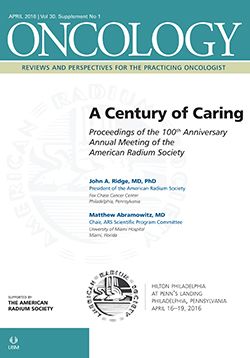(S015) The Impact of Adjuvant Postoperative Radiation Therapy With or Without Chemotherapy on Survival After Esophagectomy for Esophageal Carcinoma
In this national hospital-based study, the addition of postoperative radiation therapy with or without chemotherapy following esophagectomy was associated with improved survival for patients with node-positive disease or positive margins.
Andrew T. Wong, MD, Meng Shao, MD, Justin Rineer, MD, Anna Lee, MD, David Schwartz, MD, David Schreiber, MD; Department of Veterans Affairs, New York Harbor Healthcare System; UF Health Cancer Center - Orlando Health
INTRODUCTION: It is unclear whether postoperative radiation therapy (PORT) or chemotherapy after esophagectomy improves overall survival (OS) over surgery alone. The objective of this study was to analyze the impact on OS from the addition of PORT with or without chemotherapy following esophagectomy, utilizing a large, hospital-based dataset.
MATERIALS AND METHODS: The National Cancer Data Base (NCDB) was queried to select patients diagnosed with stage pT3–4Nx-0M0 or pT1-4N1–3M0 esophageal carcinoma (squamous cell or adenocarcinoma) from 1998–2011 treated with definitive esophagectomy with or without PORT and/or chemotherapy. OS was analyzed using the Kaplan-Meier method and compared using the log-rank test. Multivariate Cox regression analysis was used to identify covariates associated with OS.
RESULTS: There were 4,893 patients included, of whom 1,153 (23.6%) received PORT. For the entire cohort, PORT was associated with a significant but modest improvement in median and 3-year OS (3-year OS 35.2% with PORT vs 32.3% with surgery alone; hazard ratio [HR], 0.77 [95% CI, 0.71–0.83]; P < .001). On subgroup analysis, PORT was associated with improved OS for patients with node-positive disease (3-year OS of 34.3% with PORT vs 27.8% with surgery alone; P < .001) and positive margins (3-year OS of 36.4% with PORT vs 18% surgery alone; P < .001). When chemotherapy usage was incorporated, sequential chemotherapy was associated with the best survival outcomes (P < .001). Multivariate analysis revealed that the addition of chemotherapy to RT, whether sequentially or concurrently, was a strong prognostic factor for OS.
CONCLUSIONS: In this national hospital-based study, the addition of PORT with or without chemotherapy following esophagectomy was associated with improved survival for patients with node-positive disease or positive margins.
Proceedings of the 98th Annual Meeting of the American Radium Society - americanradiumsociety.org

Targeted Therapy First Strategy Reduces Need for Chemotherapy in Newly Diagnosed LBCL
December 7th 2025Lenalidomide, tafasitamab, rituximab, and acalabrutinib alone may allow 57% of patients with newly diagnosed LBCL to receive less than the standard number of chemotherapy cycles without compromising curative potential.